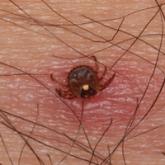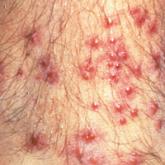Environmental Dermatology

What's Eating You? Sticktight Flea Revisited
The sticktight flea (Echidnophaga gallinacea) earns its name by embedding its head in the host's skin. It has been found in many species of birds...
From the Department of Dermatology, Wayne State University, School of Medicine, Detroit, Michigan.
The author reports no conflict of interest.
Correspondence: Steven D. Daveluy, MD, 18100 Oakwood Blvd, Ste 300, Dearborn, MI 48124 (sdaveluy@med.wayne.edu).

Patients with delusional infestation frequently bring specimens and examining these specimens is important in establishing a therapeutic relationship. The minute brown scavenger beetle is a member of the family Latridiidae. It is found in moist environments and feeds on mold. It poses no threat to humans, but it is important that dermatologists recognize it because it may be contained in specimens brought by patients.
Practice Points
Delusional infestation is the fixed false belief of skin infestation with a pathogen. Patients will often bring “proof” of their infestation to their visit to a physician. The presentation of a specimen was previously referred to by several names that reflected the receptacle that the patient utilized to bring the specimen (eg, a baggie or matchbox), but now the more encompassing term specimen sign is employed.1 Establishing rapport with the patient is critically important in the treatment of delusional infestation. Examining the specimen samples brought by the patient is a simple manner of communicating to a patient that the clinician is empathetic to and respectful of his/her concerns.2,3 The specimens often consist of dirt, dust, debris, fibers, and skin flakes and fragments, but they also have been reported to contain flies and insect parts.4,5 In our case, the patient captured a minute brown scavenger beetle with adhesive tape.
A woman in her mid-30s with a history of generalized anxiety disorder presented to the dermatology clinic with a concern of bugs infesting her skin. The symptoms occurred just after she moved into a new home with her family approximately 4 months prior to presentation. She felt the home was not cleaned properly, but they could not afford to move. She reported a crawling sensation that she identified as bugs biting her all over her body. Prior to presentation in the dermatology clinic, she and her family were treated by primary care for scabies 3 times with permethrin cream, and she was prescribed 1 course of oral ivermectin. She reported seeing bugs all over her house, which led her to clean her home and clothing many times. She was more concerned now because she thought her 2 children also were starting to be affected.
Physical examination revealed pressured speech, and the patient became tearful several times. The skin demonstrated several excoriations in various stages of healing on the breasts, legs, and upper back, as well as small scars in the same distribution. She brought several specimens stuck to clear tape to the visit. Examination of the specimens revealed fabric fibers; various debris; and a small, brown, 6-legged beetle with punctate indentations in rows along the wing covers (Figure). The head was narrower than the thorax, which was narrower than the abdomen.
We diagnosed the patient with a delusional infestation and discussed the beetle that we saw when examining the specimen the patient brought to the clinic. We provided reassurance that the minute brown scavenger beetle is not pathogenic and was present incidentally. Thus far, the patient has been resistant to initiating specific therapy for the delusional infestation, such as risperidone, olanzapine, or pimozide. We continue regular follow-up appointments with the patient to continue building the therapeutic relationship and revisiting the subject of treatment.
Minute brown scavenger beetles are arthropod members of the family Latridiidae. They also are commonly referred to as plaster or mold beetles. They are small (0.8–3.0 mm) and can be found in moist environments such as dead and rotting foliage, bird’s nests, debris, moist wallpaper/plaster, and stored products. They feed exclusively on fungus, such as mold and mildew, and pose no threat to humans.6 It is important for clinicians to recognize the appearance of the minute brown scavenger beetle so as not to mistake it for a pathogenic arthropod in patients presenting with delusional parasitosis.

The sticktight flea (Echidnophaga gallinacea) earns its name by embedding its head in the host's skin. It has been found in many species of birds...

Amblyomma americanum, also known as the lone star tick, is found in much of the eastern United States. Since the mid-20th century, the lone star...

Belonging to the Trombiculidae family of mites, chigger specifically refers to the larval stage of the mite’s life cycle when it is able to bite...
